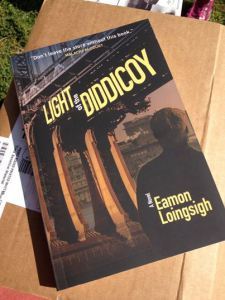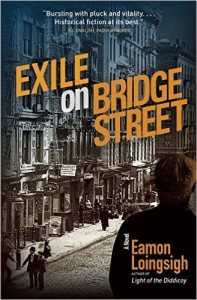Auld Irishtown Trilogy
The Auld Irishtown trilogy is three historical novels by author Eamon Loingsigh taking place between October, 1915 to March, 1920 and is set in Brooklyn, New York. The bildungsroman is told in the voice of William “Liam” Garrity looking back on his life with the Brooklyn, Irish-American gang known as The White Hand, although the story is in the traditional Irish present tense. Loingsigh (pronounced “Lynch”) has stated in interviews that the trilogy is a possible Irish answer to Mario Puzo’s “The Godfather” books, but the style of writing combines both the traditional Irish oral storytelling method along with Loingsigh’s French Symbolist poetry influences.
taking place between October, 1915 to March, 1920 and is set in Brooklyn, New York. The bildungsroman is told in the voice of William “Liam” Garrity looking back on his life with the Brooklyn, Irish-American gang known as The White Hand, although the story is in the traditional Irish present tense. Loingsigh (pronounced “Lynch”) has stated in interviews that the trilogy is a possible Irish answer to Mario Puzo’s “The Godfather” books, but the style of writing combines both the traditional Irish oral storytelling method along with Loingsigh’s French Symbolist poetry influences.
The first in the trilogy is called Light of the Diddicoy (Three Rooms Press) and takes place between October, 1915 to April, 1916, was given high marks by reviewers and literary magazines and sold to a large audience. It drew attention for its many allusions to Irish and literary history and for its strong sense of voice and language and of the culture of the Irish that had settled the waterfront area in Brooklyn which had isolated itself from the rest of the city. The trilogy also uses the actual names of Irish and Italian gang members of the time, Brooklyn patrolmen, owners of businesses and chronicles historically accurate events such as the Easter Rising, the sabotage of Black Tom’s Island, longshoremen union strikes and various arrests and murders.
Light of the Diddicoy (Spring, 2014) opens with an allusion to the funeral of O’Donovan Rossa at Glasnevin Cemetery in Dublin and covers the narrator Liam Garrity’s experience emigrating from the family farm in his native County Clare, Ireland, the trip across the Atlantic Ocean in a steamship and his arrival in Brooklyn. There, the fourteen year-old Garrity works with his uncle as a longshoreman on the docks of what was once called “Irishtown” (known as the neighborhood Vinegar Hill/DUMBO now). After a falling  out with his uncle, Garrity becomes homeless and is taken by a gang member immediately to the wake of a popular White Hand Gang dockboss. There, he meets the leader of the Irish-American gang and his future mentor, Dennis “Dinny” Meehan. Garrity is brought into the home of Meehan and cared for by his wife, Sadie. Meehan then reveals that he is caring for Garrity in order to get access to Garrity’s uncle, a union recruiter. At the same time, businesses such as the New York Dock Company, the International Longshoremen’s Association, local police efforts, Italians from South Brooklyn and a revolt from within the gang by “Wild” Bill Lovett all want to take the lucrative dock and labor racket away from Meehan’s Irishmen. With all of these elements bearing down on the gang, which Garrity is now closely involved with, it is revealed that Meehan’s plan to take back power on the docks and to keep it in the hands of the Irish gang is a violent, all-encompassing and ingenious scheme. As Meehan juggles his many responsibilities, Garrity watches and becomes known as a “thief of pencils,” an allusion to his one day retelling the story of Meehan and the Brooklyn waterfront Irish gang known as The White Hand.
out with his uncle, Garrity becomes homeless and is taken by a gang member immediately to the wake of a popular White Hand Gang dockboss. There, he meets the leader of the Irish-American gang and his future mentor, Dennis “Dinny” Meehan. Garrity is brought into the home of Meehan and cared for by his wife, Sadie. Meehan then reveals that he is caring for Garrity in order to get access to Garrity’s uncle, a union recruiter. At the same time, businesses such as the New York Dock Company, the International Longshoremen’s Association, local police efforts, Italians from South Brooklyn and a revolt from within the gang by “Wild” Bill Lovett all want to take the lucrative dock and labor racket away from Meehan’s Irishmen. With all of these elements bearing down on the gang, which Garrity is now closely involved with, it is revealed that Meehan’s plan to take back power on the docks and to keep it in the hands of the Irish gang is a violent, all-encompassing and ingenious scheme. As Meehan juggles his many responsibilities, Garrity watches and becomes known as a “thief of pencils,” an allusion to his one day retelling the story of Meehan and the Brooklyn waterfront Irish gang known as The White Hand. 
Exile on Bridge Street (Three Rooms Press, Fall, 2016) has not yet been released, but covers the much broader time frame of April, 1916 to February, 1919. It chronicles Garrity’s continued coming-of-age within the White Hand Gang and his desperation in getting his mother and sisters out of Ireland during World War I and the fallout of Ireland’s Easter Rising while many elements in New York attempt to crush the gang and their old streetwise and Irish-influenced ways.
The last book in the trilogy, expected to be named Divide the Dawn, will be released sometime after Exile on Bridge Street. The culmination of the trilogy is expected to be particularly violent with many of the gang’s members meeting their end.





